[四国EPO・四国ESDセンターが、みなさんにおすすめしたい!と思った事例をご紹介していきます]
神山発「まめのくぼプロジェクト」 / Kamiyama’s “Mamenokubo Project” /
中国四国地域の耕作放棄地面積は、経営可能な耕地の約20%(※1)に迫ろうとしており、全国平均と比較するとかなり高めで推移している。この傾向は、四国の山間地域では特に顕著で、人口減少・過疎とあわせ、重要な地域課題である。
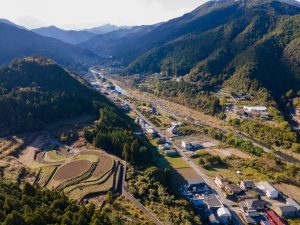
(※2)
この課題に向き合い活動を続けているのが、徳島県立城西高校神山校「まめのくぼプロジェクト」である。町内の谷地区の段畑、通称「まめのくぼ」を地域の方から借り受けて栽培を始めたのが2018年。当初は、70年以上神山で継がれている「神山小麦」の栽培からスタートしたそうだ。

集落を通り抜けた急斜面に広がる段畑は管理面積 約9,000㎡、耕作面積 約2,100㎡に及ぶ。実践の場は、毎年、さまざまな作物が栽培されており、何を植えるかは、生徒同士の話し合いや検討の中で決まる。取材に訪れた日は、ちょうど綿の花が開花していた。小麦やソバの栽培とともに、お茶やビワも植栽されている。
また、中山間地においては、獣害対策は必須、植栽地の周囲には電気柵がはりめぐらされている。ここではシカとの共生もテーマとなっている。さらに、耕作放棄地を耕地として再生し維持するために、栽培技術の習得や野生動物から作物を守る方法、段畑を維持するための石積みの補修など、やらなければならないことは、沢山ある。それに加えて、有機JAS登録や生物多様性認証にもチャレンジしており、ここはまさに学びと実践の先進地といっても過言ではない。
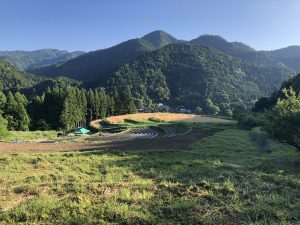
(※2)
放棄された農地を再生することが「大変」なのは間違いない。しかし、このプロジェクトに関わる生徒からは、「大変」以上に「まめのくぼが好き」「楽しい」「将来農家をやりたい」という感想や夢を沢山聞くことができた。その原動力は何なのだろう。先輩から引き継いだこと、新たな挑戦とやりがい、地域内の人に知ってもらおうと始めた「まめのくぼのつどい」など、そこには、紛れもない生徒の本気があり、それを受けとめて返してくれる地域の懐の深さ・温かさを実感し、そこにヒントがあるのではと感じた。
もっとみんなに知ってほしい。生徒の思いが地域の力となって、「まめのくぼプロジェクト」の発信は続く。
※1:中四農政局資料https://www.maff.go.jp/j/council/seisaku/nousin/bukai/h27_chiho_kondan/chushi/pdf/siryou_2.pdf
※2:写真提供協力(徳島県立城西高校神山校)
Kamiyama’s “Mamenokubo Project”
The area of abandoned farmland in the Chugoku-Shikoku Region is approaching about 20% of the total manageable arable land (※1), which is significantly higher than the national average. This trend is particularly pronounced in the mountainous areas of Shikoku, making it a critical regional issue alongside population decline and rural flight.

(※2)
The “Mamenokubo Project” at the Kamiyama Branch School of Tokushima Prefectural Jyosei High School is actively taking on the challenge. It began in 2018, when students borrowed a terraced field in the Tani district, known colloquially as “Mamenokubo,” from the local residents. Initially they cultivated “Kamiyama Wheat,” a variety of wheat which has been grown in Kamiyama for over 70 years.

The terraced fields, spreading over the steep slopes outside the village, have a management area of about 9,000 m2 and a cultivation area of about 2,100 m2. Every year, students grow various crops, deciding what to plant through mutual discussion and careful deliberation. The day I visited, the cotton flowers had just come into bloom, and in addition to wheat and buckwheat, they were also growing tea and loquats.
In the mountains, countermeasures to prevent damage from wild animals are vital, so the field is surrounded by an electric fence. Coexistence with deer is also one of the themes of the project. Furthermore, reclaiming and maintaining abandoned farmland involves a mountain of work, from learning farming techniques and how to protect crops from wild animals, to repairing the stonework supporting the fields. On top of that, they have obtained JAS organic certification and Tokushima’s biodiversity certification. It wouldn’t be an exaggeration to say this place stands at the forefront of applied learning.

(※2)
There is no question that reclaiming abandoned farmland is difficult. However, the students that I’ve spoken to involved with this project don’t seem to mind. The vast majority told me things like, “I love Mamenokubo,” “It’s fun,” and “I want to be a farmer in the future.” What is it that drives them? Is it a sense of duty to continue what they inherited from their seniors at school? A feeling of accomplishment from trying new things? The “Mamenokubo Meeting” they started to spread the word about what they’re doing? Or is it the profound depth and warmth of the community that accepts and responds to their unmistakeable efforts? That, I believe, may be the key.
I hope more people will learn about the students’ dedication, which is becoming a source of strength for the region, and that the “Mamenokubo Project” continues to spread its message.
※1: Chugoku-Shikoku Agricultural Administration Bureau document
※2: Photos courtesy of Tokushima Prefectural Jyosei High School Kamiyama Branch School
“Mame no kubo 项目”
中四国地区的撂荒耕地面积已接近可耕地总面积的20%,远高于全国平均水平。这一趋势在四国的山区尤为明显,人口减少和过疏化问题交织,使其成为该地区的重要课题。

面对这一挑战并持续开展相关活动的是德岛县立城西高中神山校的“Mame no kubo项目”。该项目始于2018年,最初由学校向当地居民租借镇内谷地区的梯田——通称“Mame no kubo”进行耕作。最初,他们从种植在神山地区传承70余年的“神山小麦”开始。

梯田位于穿越村落的陡峭坡地之上,管理面积约9,000平方米,可耕种面积约2,100平方米。每年,学生们都会种植各种作物,并通过讨论和研究决定具体种植品种。采访当天,正值棉花盛开。除了小麦和荞麦,这里还种植了茶树和枇杷等农作物。
在山区农业中,防范野生动物侵害是不可或缺的环节,因此,种植地周围设置了电围栏。如何与鹿共存也是该项目的一大主题。为了复耕并维持这些撂荒地,学生们不仅要掌握农作物种植技术,还要学习如何保护作物免受野生动物侵害,并进行梯田石墙的修复等工作。此外,他们还挑战了有机JAS认证和生物多样性认证。这里不仅是学习的场所,更是实践的前沿基地。

毫无疑问,复耕撂荒地的过程是“艰难”的。然而,参与该项目的学生们却纷纷表示,他们的感受远不止“艰难”,更多的是“喜欢Mame no kubo”“很有趣”“未来想成为农民”等积极的想法和梦想。那么,这股动力来自何处?从前辈手中接过的经验、新的挑战及其意义、为了获得本地人的理解而开展的“Mame no kubo集会”、还有学生们的毫无保留的认真、接受并回馈地方的包容与温暖的真实情感等,想必在这些当中便有答案。想要让更多的人了解这个项目;让学生的想法成为地域的力量,有关“Mame no kubo项目”的信息发布仍在持续。
企業が多様なステークホルダーと連携して推進する生物多様性保全活動 東芝ライテック株式会社今治事業所 / Corporate Biodiversity Champions: How Toshiba Lighting’s Multi-Stakeholder Approach Is Preserving Coastal Ecosystems
最近、ネイチャーポジティブ※という言葉を見聞きするようになりました。
「2020年を基準として、2030年までに自然の損失を食い止め、反転させ、2050年までに完全な回復を達成する」という世界的な社会目標です。その実現のためには、企業、地方自治体、NPO/NGO、個人などすべての主体が、それぞれの業務や活動において、生物多様性の保全に資する選択をするとともに、保全活動を推進することが求められます。地域における企業の実践事例として、東芝ライテック株式会社※今治事業所(愛媛県今治市)の取組をうかがいました。
東芝グループがネイチャーポジティブの実現に貢献することを目指し、国内外の約60拠点で生物多様性保全活動を推進するとした方針を受け、東芝ライテック株式会社今治事業所(以下、今治事業所)では、織田ヶ浜(愛媛県今治市)において、ウンランやハマビシなど希少植物を含む海浜の生態系保全活動を展開しています。
東芝グループの指針として、各拠点の地域特性や課題に応じた取組を地域のステークホルダーとともに行うこと、活動の際には「連携」「広報」「教育」の視点を盛り込むことが示されています。
- <織田ヶ浜ウンラン生育地の整地作業>
- <ウンランの苗の移植。富田小児童が参加>
この指針を踏まえ、今治事業所では、愛媛県自然保護課・愛媛県生物多様性センターや地元NPOなどから、ウンラン等の保全に係る知見・アドバイスを得るとともに、地域の自治会や近隣の企業に参画を求め、ウンランの生育環境を維持する整地活動をスタートさせました。生育数が減り危機的な状況であったウンランですが、愛媛県生物多様性センターが育苗に取り組み、2015年に今治事業所をはじめとする関係者と地元の富田小学校児童が織田ヶ浜に苗を移植。以降、今治事業所のコーディネートによって、同校4年生を対象に織田ヶ浜の自然観察を行うとともに、2017年からは「織田ヶ浜動植物マップ作り」も継続しています。近年、同校児童は海浜のごみにも注目し、ごみ拾いとともにごみの分析を行っています。さらに、見た目にも美しく、生きものが生息できる織田ヶ浜の環境が維持されることを目指し、啓発活動にも取り組んでいます。
- <ウンラン>
- <富田小4年生の織田ヶ浜動植物マップ作りマップづくり>
織田ヶ浜は、今治事業所の申請によって、2023年10月、「自然共生サイト」※に認定されました。認定を期に、今治事業所では、織田ヶ浜の生物多様性の魅力と保全活動について、社内をはじめ地域内外への発信にも力を入れています。東芝グループでは、織田ヶ浜の取組をモデルケースに、宇和島工場(愛媛県宇和島市)による同市津島町のサギソウの保全活動、鹿沼工場(栃木県鹿沼市)におけるオオチゴユリの保全活動などが進められています。
今治事業所は、2010年に実施した工場構内の植物生息数調査をきっかけに、生物多様性保全活動に着手し、その後も生きものに詳しい人を事業所の各部署から募って、活動を継続してきました。織田ヶ浜の保全活動が定着し、社外に出向く機会が増えたことから、本年9月、従来の体制をベースに、職員7名による生物多様性保全活動チームが発足。今後5年間を見据え、活動を継続・発展させる方針です。
「夏場、海浜の整地作業はとても暑くてたいへんですが、子どもたちや地域の皆さんが笑顔であれば、苦労も解消されます。自治会や学校、協力企業、行政、NPOなど、皆で連携してやるからこそできているのです」と生物多様性保全活動チームリーダー。織田ヶ浜を舞台に、様々なステークホルダーが連携することによって活動が発展し、持続可能な地域づくりへとつながっています。
※ネイチャーポジティブ ネイチャーポジティブ | ecojin(エコジン):環境省
※東芝ライテック株式会社 https://www.tlt.co.jp/tlt/
東芝グループの照明器具、UVライティング、サイバーフィジカルシステム、電設資材、各
種照明システムなどの製造・サービスを展開している。
※自然共生サイト 自然共生サイト|30by30|環境省
「民間の取組等によって生物多様性の保全が図られている区域」を国が認定する区域のこと。2023年度よりスタート。
Corporate Biodiversity Champions: How Toshiba Lighting’s Multi-Stakeholder Approach Is Preserving Coastal Ecosystems
Recently, the term “Nature Positive” ※ has started to become commonplace.
It refers to the global societal goal of, using 2020 as a baseline, stopping and reversing nature loss by 2030 and achieving a full recovery by 2050. Realizing this lofty vision requires all of us — corporations, local governments, NPO/NGOs, and individuals — to make biodiversity-conscious choices and promote conservation in everything we do. As a practical example of regional corporate activities, we examined the efforts of Toshiba Lighting & Technology Corporation’s ※ Imabari Office (located in Imabari, Ehime).
The Toshiba Group aims to support the securing of a nature positive world, and 60 locations around the world have adopted a policy of advancing biodiversity conservation. At the Toshiba Lighting & Technology Corporation’s Imabari Office (hereafter referred to simply as the Imabari Office), they are helping to preserve the unique coastal ecosystem of Odagahama Beach, which includes rare plants like Linaria japonica and Tribulus terrestris.
Toshiba Group’s guidelines emphasize implementing locally-appropriate initiatives with regional stakeholders while incorporating perspectives of “collaboration,” “public relations,” and “education.”
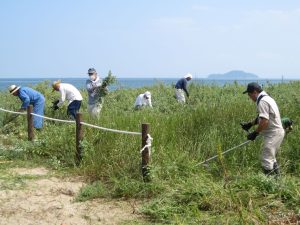 <Preparing the Odagahama Linaria cultivation area>
<Preparing the Odagahama Linaria cultivation area>
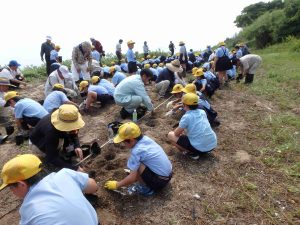 <Linaria seed transplantation. Tomita Elementary students participate>
<Linaria seed transplantation. Tomita Elementary students participate>
In accordance with these guidelines, the Imabari Office sought out expertise and advice regarding the conservation of Linaria japonica from sources such as the Ehime Prefecture Nature Conservation Division, the Ehime Biodiversity Center, and local NPOs. They also reached out to community organizations and businesses in the area to get them to participate in maintaining Linaria japonica’s growing environment. When it faced critical population decline, the Ehime Biodiversity Center undertook seedling cultivation efforts, and in 2015 those involved, including the Imabari Office, teamed up with students from Tomita Elementary School to transplant those seedlings along Odagahama Beach. Since then, the Imabari Office has organized nature observation activities at Odagahama Beach for the school’s fourth graders, which from 2017 on have included mapping out the beach’s flora and fauna. In recent years, the students have also turned their attention to beach litter, conducting beach cleanups and analyzing collected waste. Not only that, they have been doing their part to spread awareness of the need to preserve Odagahama Beach’s environment, which is teeming with beauty and life.
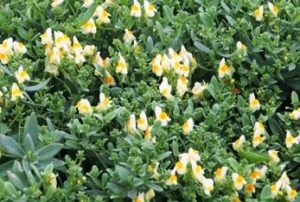
<Linaria japonica>
 <Tomita Elementary fourth graders making a map of Odagahama Beach’s plants and animals>
<Tomita Elementary fourth graders making a map of Odagahama Beach’s plants and animals>
In October 2023, Odagahama Beach was designated as a “Nature Co-existence Site” ※ following the Imabari Office’s application. With this recognition, the Imabari Office ramped up its efforts to communicate the value of Odagahama Beach’s biodiversity and the efforts to protect it, both within the company and without. The Toshiba Group sees Odagahama Beach as a model case, and has advanced similar initiatives in other locations, such as protecting Habenaria radiata in Uwajima and Disporum sessile in Kanuma.
The Imabari Office started its biodiversity conservation activities as a result of the plant habitat survey conducted on the factory premises in 2010, and has continued them by recruiting people who are knowledgable about wildlife from various departments. As the Odagahama Beach conservation activities became established and opportunities for external engagement increased, a seven-member biodiversity conservation team was formed in September 2024, building on the previous system. The team is tasked with developing and maintaining conservation activities with a five year outlook.
“The work to prepare the beach in the summer heat is grueling, but seeing the smiles of the children and other members of the community makes it all worthwhile. None of this would be possible without the cooperation of community organizations, schools, our partner companies, the local government, NPOs and more,” explains the biodiversity conservation team leader. With Odagahama Beach as its stage, various stakeholders have joined forces to develop activities that contribute to sustainable regional development.
※ Nature Positive Nature Positive | ecojin | Ministry of the Environment
※ Toshiba Lighting & Technology Corporation https://www.tlt.co.jp/tlt/
Develops manufacturing and services for Toshiba Group’s lighting fixtures, UV lighting, cyber-physical systems, electrical installation materials, and various lighting systems.
※ Nature Co-existence Site Nature Co-existence Site|30by30|Ministry of the Environment
These are areas certified by the national government as ‘zones where biodiversity conservation is being achieved through private sector initiatives and other efforts.’ The program started in fiscal year 2023.
企业携手多方利益相关者推动生物多样性保护行动
近年来,“Nature Positive(自然向好)”这一术语逐渐受到关注。“以2020年为基准,到2030年遏制并扭转自然损失,到2050年实现自然的全面恢复。” 已成为世界性的社会目标。为了实现这一目标,企业、地方政府、NPO/NGO以及个人等各类主体都需要在各自的业务和活动中做出有利于生物多样性保护的选择,并推动相关保护行动。作为企业在地方开展实践的案例之一,我们采访了TOSHIBA LIGHTING & TECHNOLOGY CORPORATION今治事业所的相关举措。
东芝集团基于其全球发展方针,致力于推进“Nature Positive”的目标,在国内外约60个据点推动生物多样性保护工作。今治事业所响应这一方针,在织田滨开展生态保护活动,致力于保护包括稀有植物如海兰草和蒺藜在内的海滨生态系统。东芝集团的指引强调,各据点应根据当地的自然特性和课题,与区域内的相关者共同推进保护行动,并在实践中融入“合作”“宣传”和“教育”三大视角。


基于这一指引,今治事业所与爱媛县自然保护科、爱媛县生物多样性中心及当地NPO组织合作,获取关于海兰草等植物保护的专业知识与建议。同时,事业所积极邀请当地自治会和邻近企业共同参与,启动了维护海兰草生长环境的土地整治活动。海兰草的生长数量曾一度减少至危机水平,为此,爱媛县生物多样性中心开展了育苗工作。2015年,在今治事业所的协调下,该中心携手当地小学——富田小学的学生,将培育出的幼苗移植到织田滨。从此,今治事业所持续组织该校四年级学生在织田滨进行自然观察活动,并自2017年起推进“织田滨动植物地图绘制”项目。近年来,学生们不仅关注海滩上的垃圾问题,还开展垃圾清理和分类分析工作。此外,为了维持织田滨的美丽景观及生物栖息环境,企业和当地组织也积极开展环保宣传活动。


在今治事业所的推动下,织田滨于2023年10月被正式认定为“自然共生场所”。借此契机,该事业所进一步加强了对企业内部及社会各界的宣传,推广织田滨的生物多样性的魅力及保护工作。东芝集团亦以织田滨的实践为蓝本,在宇和岛工厂开展津岛町的鹅毛玉凤花保护活动,并在鹿沼工厂实施宝珠草的保护项目。
今治事业所自2010年起,通过对厂区内植物生息状况的调查,正式启动生物多样性保护行动。此后,该企业不断从各部门招募擅长生物研究的员工,推动相关活动的长期开展。随着织田滨保护工作的深入推进,事业所逐步拓展至企业外部的合作。今年9月,该事业所在原有基础上成立了由7名员工组成的生物多样性保护团队,并制定了面相未来五年的活动持续计划。“夏季在海滩进行整地作业确实非常辛苦,但当看到孩子们和社区居民的笑容时,我们的辛劳也就烟消云散了。正因为有自治会、学校、合作企业、政府机构和NPO组织的共同协作,这项工作才能顺利推进。”生物多样性保护团队的负责人如是说道。以织田滨为舞台,各方相关者通力合作,不仅推动了保护活动的可持续发展,也为构建可持续的地区贡献了力量。
四国の多文化共生を考える / Thinking Beyond Borders: Embracing Multicultural Coexistence in Shikoku
少子高齢化や人口減少が進む四国でも、在住外国人の方が増えてきました。高知県内では、2023年6月の時点で5,663人という統計(※)もあります。四国の多文化共生もいよいよ本腰を入れて取り組む時期に来ています。(※出入国在留管理庁ホームページ参考)
そんな中、「まぜこじゃKOCHI土佐と世界をいっちきちもんちきち」という軽快な方言を冠したイベントが、高知大学次世代地域創造センター主催で2024年1月20日に開催されました。「いっちきちもんちきち」とは、土佐弁(高知の方言)で行ってきて戻ってくるという意味です。この企画は、地域の国際人材ネットワーク形成事業・高知大学「地域×国際」セミナーとして2023年度から始まり、今回で第2回となります。参加者は約100名、高知県内はもとより四国、四国外から国際交流や地域づくり等に関心のある地域の関係者や企業、自治体など、さまざまな主体の参加が見られました。
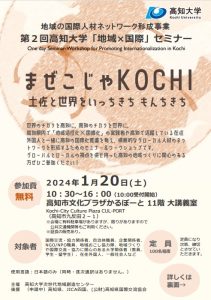
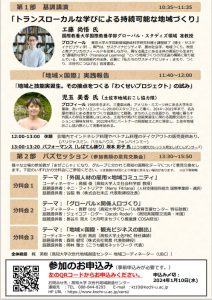
当日は「地域活性化×国際化」を在住外国人の方と一緒に考え、横断的なグローカル人材のネットワーク形成を進めようと、トランスローカルな学びをテーマとした基調講演や地域での実践報告、3つのテーマにわかれた分科会でのセッションが行われました。このテーマで関係者が集まる機会は、少ないとみられ、活発な交流の機会となりました。
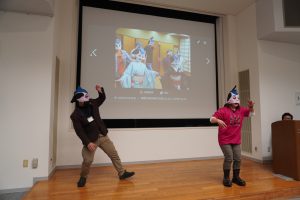
<アイスブレイクでのしばてん踊り>
多文化共生の動きは、今後も加速化するとみられます。今回は地域活性化がテーマでしたが、他にもさまざまなテーマでの企画に関する情報が、四国内でも見られるようになりました。点から線・面へ、四国の多文化共生を身近に感じてもらうための取組は続きます。
Thinking Beyond Borders: Embracing Multicultural Coexistence in Shikoku
Even in Shikoku, where low birthrates, an aging population, and population decline are becoming serious problems, the number of foreign residents continues to increase. According to statistics from the Immigration Services Agency homepage, Kōchi Prefecture alone was home to 5,663 foreign residents as of June 2023. It’s time for Shikoku to seriously address the realities of multicultural coexistence.
Against that backdrop, an event with a lively dialect-inspired title, “Mazekoja KOCHI: Icchikichi Monchikichi Tosa and the World,” was hosted on January 20, 2024 by Kōchi University’s Center for Regional Sustainability and Innovation. Icchikichi Monchikichi is a phrase from the Tosa dialect (the dialect commonly spoken in Kōchi Prefecture) which means “to go and come back.” The planning started in 2023 as a one day seminar-workshop for promoting internationalization in Kochi, and this is the second time it has been held. Approximately 100 participants attended, including stakeholders from various sectors such as international exchange organizations, community development groups, businesses, and local governments—not only from Kochi Prefecture but from across Shikoku and beyond.


The day’s program focused on exploring “regional revitalization and internationalization” together with foreign residents with the aim of developing networks of cross-disciplinary “glocal” talent. Activities included a keynote speech about translocal learning, a case report about a regional project, and breakaway sessions divided into three specific themes. An event like this one doesn’t come along every day, so the discussion was quite lively.

<Ice-breaking activities included the traditional Shibaten dance>
The movement toward multicultural coexistence is expected to accelerate in the coming years. While regional revitalization was the theme of this particular event, information about plans addressing various other themes is becoming increasingly visible even in Shikoku. The effort to help residents experience multicultural coexistence in their daily lives continues to expand. What starts as isolated points connect to form lines, and eventually those lines connect as well, until the whole region is involved.
思考四国的多元文化共生
在少子高龄化和人口减少加剧的四国,居住的外国人却在逐渐增加。据统计,截至2023年6月,高知县内的在住外国人已达5,663人。因此,四国的多元文化共生问题正迎来需要认真应对的关键时刻。在这样的背景下,由高知大学次世代地域创造中心主办的活动 “まぜこじゃKOCHI 土佐と世界をいっちきちもんちきち”(融合KOCHI 土佐与世界的往来交流)于2024年1月20日成功举办。其中,“いっちきちもんちきち”是土佐方言,意为“去而复返”。该活动作为高知大学“地域×国际”系列研讨会之一,始于2023年度,至今已是第二届。本次活动共吸引了约100名参与者,除了高知县内人士,还有来自四国其他地区及四国外的相关人士,包括对国际交流及地方振兴感兴趣的地区工作者、企业代表、地方政府人员等多个主体。


当天,围绕“地域活性化×国际化”这一主题,与在住外国人共同探讨地方振兴与多元文化共生,并以 “跨地区学习”为核心展开活动。活动包括主题演讲、地方实践案例分享,以及围绕三个核心议题的分组讨论。由于围绕这一主题的交流机会较少,本次活动便成为深度活跃交流的机会。

多元文化共生的进程,预计今后将进一步加快。本次活动以“地方振兴”为核心议题,同时,有关其他各类主题的企划的信息,在四国地区内也已经能够见到。从点到线与面,让人们切身感受到四国的多元文化共生的努力将持续下去。



